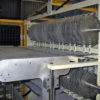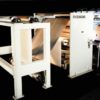Wrinkling of webs can be caused by baggy edged rolls, misaligned rolls between the unwind position and the sheeter’s draw drum, severe wrap around rollers, or when running multiple rolls, friction between webs. Here are some suggestions:
Baggy edged rolls
An unevenly coiled roll has imbalanced tension across the face of the web. In such cases, as the roll unwinds, one side of the web is not pulled as tightly as the other. This ‘baggy edge’ can result in wrinkles.
There should be a mechanical skew adjustment that can address this condition. In some cases, a correction is allowed at the unwind. A mechanism, usually mounted on the Operator side, moves the shaft (in the case of shafted roll stands) or the arbor’s arm (in the case of a shaftless roll stand) forward toward the cutter (slackening) or away from the cutter (tightening). In other designs, there is a carrier roll located between the unwind and the cutter that can be pivoted in a similar fashion to provide a likewise result.
Sometimes, the slackness of the material is near the center of the roll, not the ends. If this condition is a continuing issue, a bowed roll strategically placed after the unwind and prior to the cutter infeed might be required to evenly spread the web(s).
Misaligned rolls
Unevenly positioned rolls are usually associated with ill machine installation or when an existing roll is replaced. In both cases, use of skew adjustment maybe inadequate to resolve the wrinkling problem.
Before attempting to identify the existence of a misaligned roll(s) begin with these ground rules:
Move all skew adjustments to their center position to insure maximum correction in either direction after rolls are levelled and trammed.
Clearly identify the web path from the unwind to the cutter’s bottom pull roll (also known as the draw drum).
Always begin the measurement process at the cutter and move sequentially back to each roll in the web flow, toward the associated unwind position. This is because the position of the draw drum cannot easily be adjusted, whereas the rolls in the web conditioning system and associated carrier rolls can be more simply altered.
Also record all rolls’ level and tram prior to adjusting any of the cross members. It might be determined that a series of rolls within a frame are out of square and that shimming the decurl assembly’s frame will achieve the desired solution, rather than realigning several rolls.
First, using a precision machinist level, measure and record the horizontal of each roll in the web path, beginning with the draw drum and then in sequence to the next roll moving back to the unwind. Rolls, across the face, should be within +/- 1/64” (+/- 0.38 mm) of levelness. Be attentive to any trends or groupings of rolls that are uneven, as it may indicate a section of the machine frame that may need to shimmed. Repeat the process for each web path.
Review the results and adjust roll levelness throughout as the data dictates.
Second, using a tape measure, check tram between adjoining rolls, beginning with the distance between the draw drum and the bottom slitter shaft, then the bottom slitter shaft and the lead in roll, then the lead in roll and so on. Be attentive to any trends or groupings of rolls that are out of tram.
The most accurate method for determining parallelism between rollers is to wrap the tape measure around both rolls and record the length, on both the drive side and Operator side of the machine. Any difference in the two recordings is twice the out of parallel distance, so 1/32” differential indicates 1/64” variance in tram from side to side.
Review the measurements for tram and make adjustments as required.
Severe wrap around rollers
Wrinkles can be drawn around rollers if the wrap is excessive (90° or greater), the roll diameter is small (3” diameter or less) or both. If the web path can not be easily altered to minimize the degree of wrap, consider replacing the existing roll with a 6” diameter roller.
Friction between webs
When sheeting multiple webs, the best practice is to keep them separated until immediately before the cutter infeed. This approach avoids the gathering of webs that can lead to wrinkling. Locating carrier rolls for each web that supports the flow yet keeps them apart from one another avoids folds caused by friction between webs.






